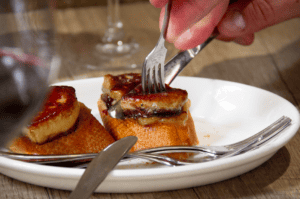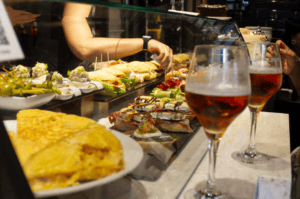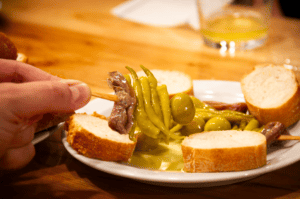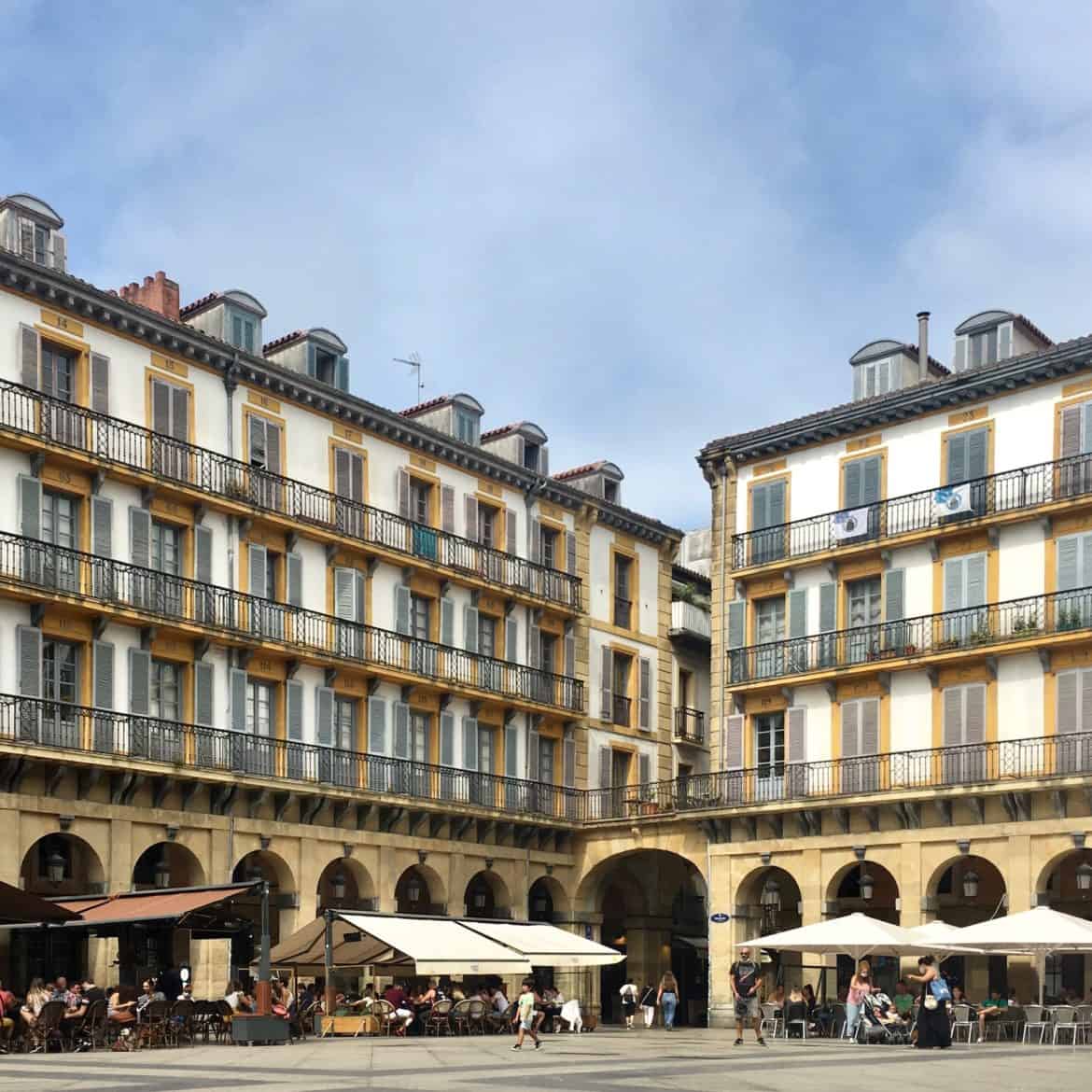In the heart of San Sebastián, a city renowned as much for its picturesque vistas as for its food, our San Sebastián Food Tour explores the must-taste dishes from this magical place.The tour offers a gateway to understanding the deep-seated traditions and cultural nuances that define the Basque culture, including the famous Pintxos, the region’s iconic bite-sized delights.
San Sebastián, or Donostia in the Basque tongue, paints a vivid picture of a city where history has intricately shaped its culinary identity. Lying gracefully along the Bay of Biscay, it has evolved from a quaint fishing village into a vibrant, urban enclave, with each era contributing uniquely to its food traditions. This evolution is most prominently displayed in its Pintxos, which are as much a feast for the palate as they are a reflection of local customs and historical influences.
The San Sebastián Food Tour takes participants from an age-old Pintxos bar, established in 1942, to a renowned Basque restaurant, each location chosen for its historical significance and culinary excellence. As the tour weaves through the Center neighborhood and into the lively Gros area, it provides insights into how the city’s history is deeply embedded in its love for Pintxos.
San Sebastián: A Cultural and Culinary Overview
In the heart of the Basque Country, San Sebastián stands as a beacon of cultural distinctiveness and historical richness. This region, celebrated for its unique language, Euskara, and a strong sense of identity, sets a fascinating stage for the city’s culinary narrative. The Basque Country’s location, bridging Spain and France, has nurtured a diverse cultural environment, influencing every facet of life, including the culinary arts. San Sebastián, a central figure in this region, mirrors this diversity, blending age-old traditions with modern influences.
San Sebastián’s geographical position, edged by the sea and surrounded by fertile lands, has been pivotal in defining its food culture. The abundant seafood from the Bay of Biscay and fresh produce from nearby farms have long influenced the local cuisine. Historically evolving from a quaint fishing village to a sophisticated city, San Sebastián has seen a myriad of culinary influences, especially during its time as a royal resort.
San Sebastián’s status as a premier culinary destination is deeply rooted in its history, reflected in its impressive array of Michelin-starred establishments. However, the true flavor of the city is best experienced in its lively Pintxos bars and vibrant local markets, where everyday culinary magic happens. The city’s passion for gastronomy is also evident in its numerous food festivals, culinary schools, and gastronomic societies, making it a must-visit location for anyone passionate about food.
The Essence of Pintxos: More Than Just Finger Food
Pintxos, the heart of Basque Country’s gastronomic culture, especially in San Sebastián, represent a culinary tradition that goes beyond mere food. Their origin dates back to the 1930s when some bars in San Sebastián, not content with ordinary tapas, began creating miniature versions of their dishes, spearing them with wooden cocktail sticks for convenience. This new style of appetizer quickly gained popularity, and by the 1940s, the trend had spread to other Basque cities like Bilbao, Vitoria-Gasteiz, and Pamplona.

Originally, these small snacks were named “pinchos” due to the toothpick (or “pincho” in Spanish) that held the ingredients together. Over time, the Basque spelling “pintxo” became more commonly used. The inception of pintxos was not just a culinary innovation but also a response to the social environment of the time. During the post–Spanish Civil War era, the practice of txikiteo (travelling from bar to bar with friends) became routine, and bars began to innovate by putting out small bits of food on the bartop.
As the years progressed, the pintxo evolved significantly. From the initial toothpick-held pickles to more complex dishes, the pintxo began to incorporate advanced techniques and diverse ingredients, including influences from global cuisines. This evolution transformed pintxos into miniature works of art, cooked to order, especially in the late 1980s in San Sebastián’s bars. The pintxo culture became deeply ingrained in the local lifestyle, with the habit of hopping from bar to bar, enjoying one or two pintxos at each venue, becoming a norm. Pairing these pintxos with local wines like txakolí or other beverages became an integral part of this experience.
The turn of the millennium saw a shift in the pintxo culture, with more global influences and chefs trained in Michelin-starred kitchens entering the scene. This global popularity and the influx of visitors to the Basque Country kept the pintxo bars bustling, especially during the summer months. The pintxo today is a blend of tradition and modernity, a symbol of San Sebastián’s culinary ingenuity.
The Art of Pintxos Preparation and Presentation
The preparation and presentation of pintxos in San Sebastián are central to their appeal, blending a respect for tradition with a flair for innovation. Classic pintxos are characterized by their simplicity and elegance. A typical example is the smoked salmon and cream cheese pintxo, which combines these ingredients on a baguette slice, enhanced by black pepper and lemon juice. This approach highlights the Basque culinary philosophy of allowing quality ingredients to shine.
Innovative twists on traditional recipes are also a hallmark of pintxos. The Spanish omelet, or tortilla de patatas, is often served in a pintxo style, skewered atop a piece of bread. The key to this dish is its texture – a gooier consistency is preferred in the Basque region. Other variations include adding different ingredients like zucchini, leeks, potatoes, cheese, or ham to the classic recipe.
 Marinated dishes, like anchovies, are another staple. These are often cured in salt or vinegar and served on bread, showcasing the perfect balance of flavors from the sea and the tanginess of the marinade.
Marinated dishes, like anchovies, are another staple. These are often cured in salt or vinegar and served on bread, showcasing the perfect balance of flavors from the sea and the tanginess of the marinade.
Some pintxos offer a blend of flavors and textures, like the combination of goat cheese and caramelized onions on bread. The preparation here focuses on properly caramelizing the onions to bring out their sweetness, complementing the tanginess of the cheese.
Bold and savory options include garlic shrimp (Gambas al Ajillo) and bacon-wrapped dates, offering a mixture of sweet and savory notes. The garlic shrimp are an adaptation of a classic tapas dish, while the bacon-wrapped dates provide a balance of sweet and salty flavors.
The presentation of pintxos is a critical aspect, with an emphasis on the arrangement of ingredients for visual appeal, color, texture, and ease of eating. Each pintxo is not only a culinary delight but also a visual treat, making it a complete sensory experience.

Beyond Pintxos: A Glimpse of Other Tour Stops
While pintxos are a highlight, San Sebastián Food Tour offer more than these iconic bites. Exploring the city’s gastronomy, one can experience a variety of flavors and traditions.
- Cider House Tour: This tour provides a traditional Basque experience, featuring a rustic meal accompanied by unlimited apple cider. It’s an opportunity to delve into one of the oldest culinary traditions of the region. The tour is set in a farmhouse setting, offering a unique and authentic Basque dining experience.
- Winery Visits: San Sebastián is also known for its wine production, especially the Txakoli wine, a lightly sparkling white wine perfect for pairing with local cuisine. The wineries offer a variety of wines, including vintage-dated varietals and dessert wines like Port and Cream Sherry, often served with Basque cheesecake, a modern Spanish dessert originating from the region.
- Exploring Local Cheesecakes: The famous Basque burnt cheesecake, known for its caramelized top, offers a unique taste experience. Originating from a local restaurant in San Sebastián, this dessert has gained wide popularity for its distinct flavor and texture.
- City Walks and Biking Tours: Beyond food, tours often include exploring the city’s beautiful landscapes, historic buildings, and unique cultural sites. These tours blend gastronomic experiences with cultural and historical exploration, offering a well-rounded experience of San Sebastián.
Please head to the San Sebastián Food Tour official page for the full description of the tour.
San Sebastián, with its rich culinary heritage and diverse gastronomic offerings, invites food enthusiasts to embark on a journey of discovery. From the iconic pintxos to rustic cider houses, fresh oysters, winery visits, and unique desserts like the Basque cheesecake, the city offers a feast for the senses. The food tours in San Sebastián are more than just culinary explorations; they are cultural immersions that reveal the heart and soul of Basque cuisine.
These tours are about experiencing the essence of the Basque way of life. They offer a chance to connect with the local culture, understand its traditions, and create lasting memories. Whether you are a seasoned foodie or a curious traveler, San Sebastián’s food has something to offer everyone.
So, if you are planning a trip to Spain, consider adding San Sebastián to your itinerary. Join San Sebastián Food Tour, immerse yourself in the local culture, and enjoy the unforgettable flavors of this gastronomic paradise
